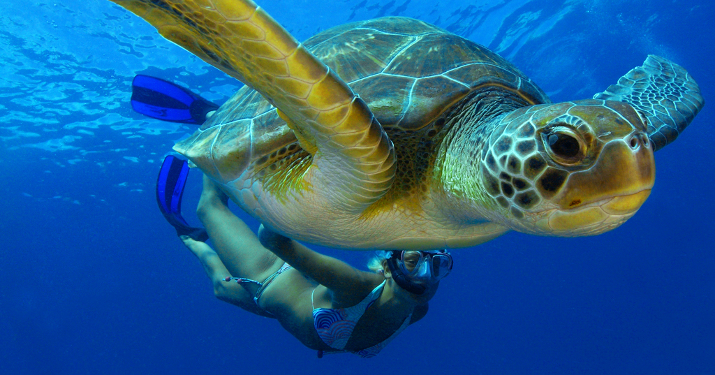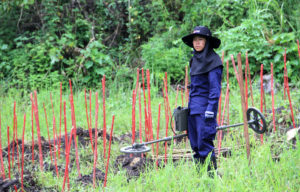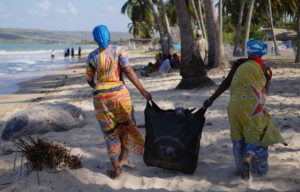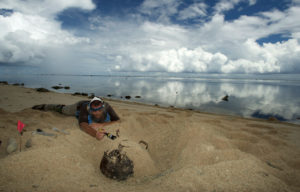
Green sea turtle, Tenerife. Photo: CCBY Philippe Guillaume
Sea turtles make comeback after years on the brink
Decades of hard work to protect sea turtles are now paying off. A number of countries report larger numbers of these armoured but vulnerable creatures.
Share
The Archie Carr National Wildlife Refuge
This protected beach stretches along 20 miles of the Florida coast, providing a haven for several species of sea turtles.
It is estimated that up to a third of North American green turtles and loggerhead turtles lay their eggs in the reserve, which also gets occasional visits from the rare leatherback turtle.
The protected area is named after late Dr. Archie Carr, Jr., an influential ecologist who dedicated himself to save the world’s sea turtles.
Other categories
Region: Global, Latin America
There used to be so many green sea turtles on Caribbean beaches during nesting season that a person could walk on their shells along the coast and never touch the sand. We know this from the logbooks of some of the first European ships to reach the New World.
But the sailors quickly realised that the turtles were an easy catch, and soon thousands of turtles were being butchered for meat when they came to the coast to lay their eggs. Even today, green sea turtles are known as ‘soup turtles’ in some languages.
When sea turtles were finally declared a protected species in the USA in 1973, they were on the verge of being eaten to extinction.
40 years of protection pay off
In 1991, the Archie Carr nature reserve was established on a stretch of Florida coast. Fewer than 50 turtle nests were registered in the reserve during the first year. But since then, numbers of nests began to climb. A sea turtle only starts laying eggs at around 30 years of age, and during the first decade of the Archie Carr reserve, the number of nests slowly increased to around 200.
Then numbers started booming. In 2011, researchers counted 6,023 nests on the beach, and the 2015 count broke all records, with a total of 14,152 nests. As each nest can contain up to 200 eggs, this could mean millions of new turtles.
Several other countries also report rising numbers of sea turtle nests. In Hawaii, the numbers of turtles have increased steadily since 1973, while the Solomon Islands have registered twice the number of nests since 1995. In Peru, 70 nests have been found in recent years, compared to a total of only one nest prior to 2001.
On the Caribbean island of St. Croix, previously a Danish colony, sea turtles have also started to return, after years of efforts to protect their nests.
Red light saves turtle hatchlings
“What we’re seeing in Florida now is primarily the result of the United States starting to protect the turtles in the 1970s. But there are also other reasons that contribute to the strong progress we’ve seen in recent years,” says David Godfrey, Executive Director of the Sea Turtle Conservancy, an organisation that works to protect and study the animals.
As an example, the intensive Florida shrimp industry is now required by law to use special nets that allow caught sea turtles to escape. According to David Godfrey, this saves around 80 percent of caught turtles from drowning.
In addition, there are now regulations about what property owners are allowed to build close to the sea, so that they don’t block the beach and prevent turtle nesting.
Recently, a new discovery has led to a breakthrough:
“For a long time, we have known that artificial lighting from properties along the coast disorients turtle hatclings, and lure them inland, where they die,” says Godfrey.
“But after research and lots of trial and error, we have discovered that reddish light does not confuse the hatchlings. So we can save them simply by replacing the bulbs along the coast”.
However, this is easier said than done, as the cost of changing the illumination of a large property can run into tens of thousands of dollars, causing some managers to hesitate.
New hope after oil disaster
That changed in 2010, when the Deepwater Horizon oil rig exploded, leaking huge amounts of oil into the Gulf of Mexico. The oil company BP was made to pay billions of dollars in reparations for the environmental damage caused.
“While the oil spill was a serious blow to the sea turtles, I still think that they will get through this. Partly because we are able to do so much with our part of the money paid in damages,” says David Godfrey. The Sea Turtle Conservancy applied for some of the money from the emergency fund, in order to change the lighting all along the Florida coastline. The money was granted, and the project is a success, according to Godfrey:
“I now have three employees who spend all their time visiting hotels and apartment block on the coast, offering them to help change their lighting to the reddish type that doesn’t confuse turtle hatchlings. We already carried out hundreds of lighting projects, and every hotel we work with means a huge stretch of the coast made safer for the turtles”.
Despite the substantial progress in recently years, all species of sea turtles remain under threat. In a recent report, marine biologist Wallace J. Nichols notes that even though the efforts to protect turtles and beaches have meant world sea turtle numbers are “way up”, problems such as climate change and plastic pollution continue to pose serious challenges to their future.








